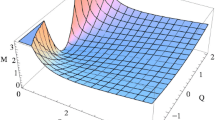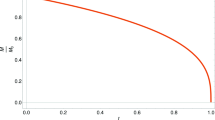Abstract
Macroscopic irreversible processes emerge from fundamental physical laws of reversible character. The source of the local irreversibility seems to be not in the laws themselves but in the initial and boundary conditions of the equations that represent the laws. In this work we propose that the screening of currents by black hole event horizons determines, locally, a preferred direction for the flux of electromagnetic energy. We study the growth of black hole event horizons due to the cosmological expansion and accretion of cosmic microwave background radiation, for different cosmological models. We propose generalized McVittie co-moving metrics and integrate the rate of accretion of cosmic microwave background radiation onto a supermassive black hole over cosmic time. We find that for flat, open, and closed Friedmann cosmological models, the ratio of the total area of the black hole event horizons with respect to the area of a radial co-moving space-like hypersurface always increases. Since accretion of cosmic radiation sets an absolute lower limit to the total matter accreted by black holes, this implies that the causal past and future are not mirror symmetric for any spacetime event. The asymmetry causes a net Poynting flux in the global future direction; the latter is in turn related to the ever increasing thermodynamic entropy. Thus, we expose a connection between four different “time arrows”: cosmological, electromagnetic, gravitational, and thermodynamic.


Similar content being viewed by others
Notes
The expression “arrow of time” is misleading since time is not a vector. Time is an emergent property of changing things and can be represented by a one-dimensional continuum. Time itself is not asymmetric; the processes time parametrizes may be asymmetric.
By ‘present’ we mean the values of such parameters if the universe would be today matter dominated.
The values of the matter and curvature densities in the present epoch were calculated using the equation:
$$\begin{aligned} \varOmega _\mathrm{m,0}+\varOmega _\mathrm{k,0}=1. \end{aligned}$$(13)The values of the present scale factor were obtained from:
$$\begin{aligned} R_{0} = c {\int _{0}}^{t_{0}} \frac{dt}{a(t)}. \end{aligned}$$(14)The Second Law of Thermodynamics: the entropy of a closed system never decreases. The arrow of radiation: we only measure retarded potentials, though retarded and advances potentials are both solutions of Maxwell’s equations. The expansion of the universe: there are several asymmetric processes involved in the expansion of the universe such as the receding of distant galaxies or the diminution of the mean universal temperature. Black hole formation: black and white holes are both solutions of Einstein’s equations, related by a time reversal transformation. However, only black holes seem to exist.
Friedmann equation:
$$\begin{aligned} H^2(t)\equiv \left( \frac{\dot{a}(t)}{a(t)}\right) ^2=\frac{8\pi G}{3} \rho _m(t) - \frac{c^2 k}{R_0^2 a^2(t)}.\end{aligned}$$(28)Supermassive black holes are found in most galaxies and have masses from \(\approx 10^{6}\) to \(10^{9}M_{\odot }\) (Romero and Vila 2014). The contribution to the screening of currents by stellar mass black holes, in comparison, is negligible.
References
Bunge, M. (1967). Foundations of physics. Berlin: Springer.
Clarke, C. J. S. (1977). Time in general relativity. In J. S. Earman, C. N. Glymour, & J. J. Stachel (Eds.), Foundations of space–time theories. Minnesota studies in the philosophy of science, 8 (pp. 94–108). Minnesota: University of Minnesota Press.
Faraoni, V. (2015). Cosmological and black hole apparent horizons., Lectures Notes in Physics Switzerland: Springer International Publishing.
Gao, C., Chen, X., Faraoni, V., & Shen, Y. (2008). Does the mass of a black hole decrease due to the accretion of phanton energy? Physical Review D, 78, 024008.
Gold, T. (1962). The arrow of time. American Journal of Physics, 30(6), 403–410.
Hawking, S. W. (1968). Gravitational radiation in an expanding universe. Journal of Mathematical Physics, 9, 598–604.
Hawking, S. W. (1974). Black hole explosions. Nature, 248, 30–31.
Hawking, S. W. (1975). Particle creation by black holes. Communications in Mathematical Physics, 43, 199–220.
Hawking, S. W. (1985). Arrow of time in cosmology. Physical Review D, 32, 2489–2495.
Hayward, S. A. (1994). Quasilocal gravitational energy. Physical Review D, 49, 831–839.
McVittie, G. C. (1933). The mass-particle in an expanding universe. Monthly Notices of the Royal Astronomical Society, 93, 325–339.
Nandra, R., Lasembly, A. N., & Hobson, M. P. (2012). The effect of a massive object on an expanding universe. Monthly Notices of the Royal Astronomical Society, 422, 2931–2944.
Nandra, R., Lasembly, A. N., & Hobson, M. P. (2012). The effect of an expanding universe on massive objects. Monthly Notices of the Royal Astronomical Society, 422, 2945–2959.
Nolan, B. C. (1998). A point mass in an isotropic universe. Existence, uniqueness and basic properties. Physical Review D, 58, 064006.
Penrose, R. (1979). Singularities and time-asymmetry. In S. W. Hawking & W. Israel (Eds.), General relativity: An Einstein centennial (pp. 581–638). Cambridge: Cambridge University Press.
Perlmutter, S., et al. (1999). Measurements of \(\Omega\) and \(\Lambda\) from 42 high-redshift supernovae. Astrophysical Journal, 517, 565–586.
Planck Collaboration. (2014). Planck 2013 results. XVI. Cosmological parameters. Astronomy & Astrophysics, 571, id.A16, 66 pp.
Romero, G. E., & Pérez, D. (2011). Time and irreversibility in an accelerating universe. International Journal of Modern Physics D, 20(14), 2831–2838.
Romero, G. E. (2014). Philosophical issues of black holes. In A. Barton (Ed.), Advances in Black Holes Research (pp. 27–58). New York: Nova Science Publishers.
Romero, G. E., & Vila, G. S. (2014). Introduction to black hole astrophysics., Lectures notes in physics Berlin: Springer.
Sciama, D. (1967). Retarded potentials and the expansion of the universe. In T. Gold & D. L. Schumacher (Eds.), The nature of time (pp. 55–67). Ithaca: Cornell University Press.
Wald, R. M. (1984). General relativity. Chicago: Chicago University Press.
Wheeler, J. A., & Feynman, R. P. (1945). Interaction with the absorber as the mechanism of radiation. Reviews of Modern Physics, 17, 157–181.
Wheeler, J. A., & Feynman, R. P. (1949). Classical electrodynamics in terms of direct interparticle action. Reviews of Modern Physics, 21, 425–433.
Acknowledgements
This work is supported by Grant PIP 0338,(CONICET) and Grant AYA2016-76012-C3-1-P (Ministro de Educación, Cultura y Deporte, España).
Author information
Authors and Affiliations
Corresponding author
Appendix: Technical Details of the Cosmological Growth of Black Holes
Appendix: Technical Details of the Cosmological Growth of Black Holes
1.1 Cosmological Expansion
Black holes are co-moving with the cosmological expansion of the universe. In order to describe the increase of size of the black hole due to this expansion, we adopt the Hawking–Hayward quasilocal mass (Hawking 1968; Hayward 1994), which measures the mass of a bound source of gravitation in an asymptotically FRWL universe (Nolan 1998). Specifically, we adopt:
where \(M_\mathrm{{0}}\) is the black hole present mass and a(t) stands for the normalized scale factor. To implement this proposal, we replace Hawking–Hayward quasi-local mass in McVittie metrics (McVittie 1933) for a mass-particle embedded in a Friedmann cosmological model and, via Einstein field equations, we study the corresponding energy-momentum tensor.
For a cosmological black hole embedded in the flat Friedmann model, the generalized McVittie metric in isotropic coordinates \((t,r,\theta ,\phi )\) is (Gao et al. 2008):
where M(t) is an arbitrary function of the cosmic time t. For the open and closed Friedmann models, we propose the following metrics:
where ± is the sign of the spatial curvature. If we adopt for the function M(t) the Hawking–Hayward quasi-local mass, given by Eq. 22, the metrics above take the form:
Notice that if \(a(t)= 1\) and \(r<<R_0\), the metrics (23) and (24) reduce to the Schwarzschild metric in physical isotropic coordinates \((t,a(t)r,\theta ,\phi )\) with central mass \(M_0 a(t)\). Conversely, if \(M_0=0\), we recover the Friedmann geometries.
The asymptotically flat metric (23) and its corresponding energy-momentum tensor has been analyzed by Gao et al. (2008). The metric turns to be consistent with the energy-momentum of an imperfect pressureless accreting fluid. We emphasize that, asymptotically, the energy-momentum tensor coincides with the one of the cosmological model:
Here \(u^\mu \rightarrow (|g_{00}(r,t)|^{-1/2},0,0,0)\), \(q^\mu \rightarrow (0,q(r,t),0,0)\), and \(\rho _\infty \propto H^2(t)\), in agreement with Friedmann equations.Footnote 6
We maintain that the same result can be extend to the asymptotically curved metrics (24). According to Einstein field equations, the matter content of these geometries is an imperfect accreting fluid that, asymptotically, coincides with the one of curved Friedmann models:
where \(\rho _\infty (t) \propto H^2(t) \pm C a^{-2}(t)\), with C a positive constant, in accordance with Friedmann equations.
We have shown that the spacetime metrics given by (23) and (24) are consistent with Hawking–Hayward quasi-local mass proposal for a black hole embedded in Friedmann cosmological models. A detailed analysis of the existence of trapped surfaces for those metrics will be given in a future work. In what follows, we will assume Hawking–Hayward quasi-local mass as the effective mass of a black hole embedded in a Friedmann cosmological model.
1.2 Black Hole Accretion of Cosmic Microwave Background Radiation
The rate of accretion of CMB photons onto a black hole is given by:
where \(b = \left( 3 \sqrt{3}r_\mathrm{S}\right) /2\) is the critical impact parameter of a Schwarzschild black hole (\(r_\mathrm{S}\) stands for one Schwarzschild radius); \(n_{\small \mathrm{CMB}}(z)\) and \(<{\epsilon }_{\mathrm{ph}}>\) are the density and energy of CMB photons as a function of redshift z, respectively:
For simplicity, we consider only supermassive black holesFootnote 7 of \(M_{0} = 10^{8}\,M_{\odot }\). Equation (29) and (22) then yields:
The variation of black hole mass by accretion of CMB photons during the cosmic time interval \(\varDelta t = t-t_{0}\) (\(t_{0}\) is the value of the present cosmic time) can be obtained by integration of the latter equation:
As mentioned above, it is expected that accretion of matter and currents also occurs, as it is actually observed in active galactic nuclei (Romero and Vila 2014). In this sense, our estimation for the growth of the black hole mass due to CMB accretion gives the absolute minimum.
Rights and permissions
About this article
Cite this article
Romero, G.E., Pérez, D. & López Armengol, F.G. Cosmological Black Holes and the Direction of Time. Found Sci 23, 415–426 (2018). https://doi.org/10.1007/s10699-017-9527-x
Published:
Issue Date:
DOI: https://doi.org/10.1007/s10699-017-9527-x




